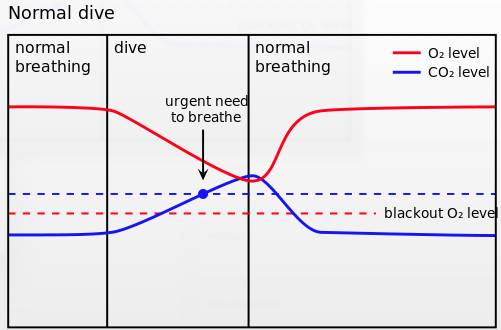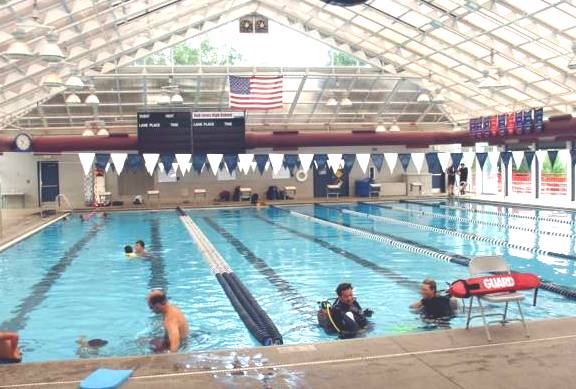When we were kids, we all had contests in the pool to see who could hold his or her breath the longest. That’s a rite of passage as a kid in summer, claiming your spot as the reigning champ of underwater breath holding. It wasn’t long before some wise guy, usually an older cousin, told you that if you took a couple of quick, deep breaths, you would be able to hold your breath even longer.
Hyperventilation may work, but that doesn’t mean it’s safe.
The Science of Hyperventilation
This tactic worked, but not for the reasons we think. Hyperventilation is the technique we were using – over breathing for a few breaths before we plugged our noses and went under. The mistaken assumption is that we were saturating our lungs and bloodstream with oxygen, which isn’t really the case.
“When we hyperventilate, we briefly override that mechanism to expel C02, which is why that ‘urge’ holds off for a few extra seconds, and we become king of the hill at the summer public pool in the game of who-can-hold-their-breath-the-longest.”
What is really happening (and stay with me here – the science is boring, but the fun starts soon) is that when we take those two or three fast, deep breaths, we’re not saturating our O2 levels, but rather disabling the mechanism that compels us to breathe. We take in oxygen, but we expel C02. Our bodies know very well when and how to expel it – which is what creates the urge to breathe. When we hyperventilate, we briefly override that mechanism to expel C02, which is why that “urge” holds off for a few extra seconds, and we become king of the hill at the summer public pool in the game of who-can-hold-their-breath-the-longest.

A graph of what happens during shallow water blackout.
Now, consider this: you’re underwater and the reflex to breathe has been muted by hyperventilation. As your body begins to demand O2 and you’re refusing to provide it, a condition called hypoxia can take over. The first sign of this is often grey out – or worse, black out. In a nutshell, everything is going along swimmingly (no pun intended) and suddenly, you’re unconscious. And unless someone notices you at the bottom of the pool, you’re dead. It is quick, and silent.
Why Does This Matter?
Which leads me to today’s topic. This. CrossFit posted on its Facebook page a short video of Ben Smith doing an underwater EMOM. (EMOM, of course, meaning every minute on the minute). Smith, the reigning CrossFit men’s champion, is swimming 25 yards underwater every minute on the minute for as long as he is able to make it across the pool without coming up.
“For better or for worse, when CrossFit Headquarters or some CrossFit celebrity posts something heinous, we just can’t wait to try it.”
Now, Smith appears to be attempting hyperventilation in the video, but it is unclear as to whether he is doing so. It really matters not, because my money is on the fact that 99% of the non-diving population simply conjures the neighborhood pool technique of hyperventilation before we hold our breath, and that most people who attempt this workout after watching the video will employ that technique.
Imagine then, if you would, the convergence of several issues that might make this video the harbinger of something very bad:
- We are a community of copycats. For better or for worse, when CrossFit Headquarters or some CrossFit celebrity posts something heinous, we just can’t wait to try it. (Have you seen all the pegboard videos on social media lately? I rest my case). You only need to look to the rash of “Let’s do this Monday!” comments on most of CrossFit’s posts, regardless of what the movement or activity is, or the continual plague of overhead squat photos to acknowledge that, let’s face it, there are a whole lot of people standing by to do a pool EMOM.
- As a general community of CrossFitters, we know little to nothing about shallow water blackout or, even perhaps, the benefits of doing any sort of swimming workout, since most of us are not programmers, exercise physiologists, or swimmers.
- The subtlety with which shallow water blackout can occur is such that, unlike doing a one-legged overhead squat on top of an Atlas stone with 135lbs, the risks are opaque.
While the odds of a CrossFitter dying after seeing Ben Smith do an underwater EMOM is admittedly slight, nonetheless, the risk is there. Worse, CrossFit’s social media team was clueless as to the existence of the risk when they initially posted the video. It wasn’t until the collective screams of free divers, competitive swimmers, and Facebook groups like Shallow Water Blackout Prevention (yes, that’s a real page) hit the page that CrossFit added a “don’t try this at home” warning.

But what continues to fascinate me is the pushback from the nuthuggers – the truly clueless who should probably have their posting privileges revoked:
- “this is NOT ‘dangerous.’ no more than any other fitness training / athletic endeavor. ego and ignorance in training is what’s dangerous.” – Incorrect. Hyperventilated pre-breathing before submersion is exactly dangerous.
- “People always have to find something to bitch about…I did underwater relays when I swam in high school and no one ever blacked out. If 25 yards is that hard for you to swim you’re probably not going to be trying this anyways.” – This is what I like to call the Russian Roulette argument. I pulled the trigger against my temple four times and never shot myself. It has a dash of “you’re probably a wimp anyway” thrown in for good measure.
- And of course, butthurt makes an appearance: “This is why we can’t have nice things. Might as well make all pools illegal with all of these butthurt ‘swimmers’.” – Swimmers in quotations. Ouch.
However for every sycophant that hurled accusatory butthurt comments, there were, thankfully, three to five common sense, logical comments admonishing CFHQ about the real dangers of shallow water blackout, and seeking to educate and warn as thoroughly as they could about the remote, albeit real, risk.
The Root of the Problem
Which leaves us at the root of the concern – which is, once again, the post-with-impunity CFHQ social media team and their ready-fire-aim approach. While CFHQ goes after Gatorade in an attempt to (allegedly) prevent hyponatremia, they seem to be all but promoting a potentially even more lethal practice. While, yes, they posted a caveat, we still see a video of the newest CrossFit role model appearing to hyperventilate before beginning another rep of his “emom.” We all know what this means – admirers will follow suit.
The calls from the swimming and diving community demanding that HQ remove the video got fairly loud:
The most dangerous risks for shallow water blackout are repetitive prolonged breathe-holding laps with little rest in between, especially if intentional or unintentional hyperventilation has occurred. SWB can happen to even the most experienced athletes. Death is almost instant. #crossfitgames needs to take this down immediately and educate their clients on the safety practices needed to protect the lives of their athletes! – Shallow Water Blackout Prevention
We should not encourage distance breath holding! Especially repeatedly. This is a dangerous activity even for trained swimmers. As an Aquatics professional who has witnessed a blackout I can assure you that we don’t want to have any incidents of people trying this. – Chris S.
First thought: Shallow water blackout. Our box lost a very fit, collegiate water polo player to shallow water blackout. No one expected it because of his level of fitness and I don’t think any of us were really aware of the serious risks until it happened. Now that we know, it’s scary to see this sort of thing promoted. – CrossFitter from California
There’s more, of course.

Let’s face it – there are probably a whole lot of CrossFitters standing by to do a pool EMOM.
Two Critical Points
In the end, two thoughts strike me as critical about using this as a tool for a safer route to overall fitness:
For the CrossFit world at large, please – do your homework. Whether it’s a swimming-related workout, an Arthur lift, or a split snatch, don’t try it just because you’ve seen it posted on social media. It scares me the number of people who chimed in with,“this is us Saturday Lindsee!!!” on the Ben Smith post. Why go to the pool and put yourself at risk while knowing zero about the risk you’re about to undertake? Everything you do, everything, in this fantastical world we call CrossFit should be approached with the utmost of advanced knowledge, preparation, and caution.
CrossFit Social Media – the same goes for you. You clearly failed to do your homework and simply reposted something you thought was cool. Unfortunately, while that tends to work for the general social media world, you have to know you have millions of followers, a large segment of whom take your stream as biblical text. The responsibility to screen what you post, especially since it involves health, is enormous. Your edited caveat doesn’t even cover the totality of the possible issues. Meaning, this is about much more than having a spotter – it’s about a deep knowledge of the physiology that can occur in breath-hold drills and educating yourselves first, then the readers, as to that physiology. The smart thing would have been to simply remove the post knowing that this issue was bigger than CrossFit has the capacity to understand, or to seek to understand it, which it appears that you do not.
More Like This:
- CrossFit Should Not Be Based on a Dare
- Bad Advertising and Hubris: Will CrossFit HQ Ever Apologize?
- Dear CrossFit: Talayna Deserves Better
- New on Pulse Beat Fit Today
Photo 1 courtesy of Shutterstock.
Photo 2 by Acdx, via Wikimedia Commons.
Photo 3 courtesy of Jorge Huerta Photography.
Photo 4 courtesy of CrossFit Impulse.






